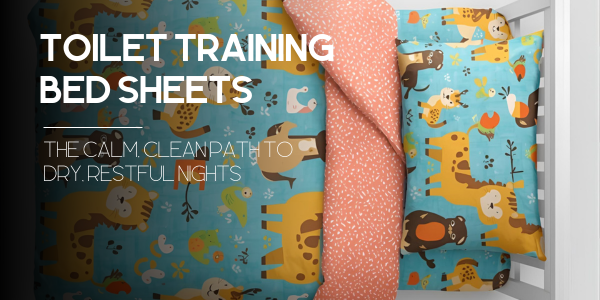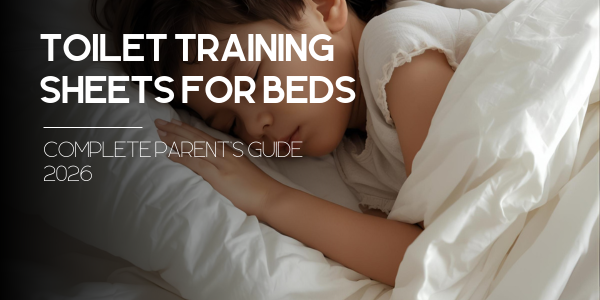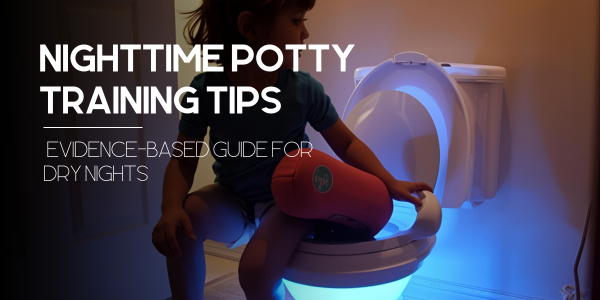Bed Wetting Bed Sheets: A Parent's Complete Resource
The Ultimate Guide to Bed Wetting Bed Sheets: A Parent's Complete Resource for Dry, Peaceful Nights
Because every child deserves to wake up confident and comfortable.
Breaking the Silence on Bed Wetting
Here's something that might surprise you: 33% of 5-year-olds and 18% of 8-year-olds experience bed wetting. That's right – if your little one is among the 5-7 million children across the country dealing with nocturnal enuresis, you're definitely not sailing this ship alone.
Look, we get it. Those 2 AM wake-ups? The mountain of laundry? The worry in your child's eyes? It's tough. Really tough. But here's the thing – bed wetting is nobody's fault. Not yours. Not your child's. It's just one of those curveballs parenting throws at us.
Quick Reality Check
You're in good company. These numbers show bed wetting is more common than most parents realize.
At Chooniez, we're not just another bedding company. We're parents who've been there, done that, and decided to do something about it. This guide? It's everything we wish we'd known when we started this journey.
The Science Behind Bed Wetting: What Every Parent Needs to Know
Understanding the Numbers

Let's talk facts – because understanding what's happening can be incredibly reassuring. Bed wetting affects kids differently at different ages, and knowing the stats helps put things in perspective.
The Gender Gap
Interesting tidbit: 66% of bed wetters are boys. Why? Scientists aren't entirely sure, but it might have something to do with developmental timing. Girls often mature slightly faster in certain areas, including bladder control.
Here's some good news that'll make you breathe easier: Every year, about 15% of kids who wet the bed naturally grow out of it. No interventions, no treatments – just time doing its thing. By age 15? Only 1% of teens still experience bed wetting.
Why Bed Wetting Happens
Alright, let's dive into the "why" – because every parent asks this question at 3 AM while changing sheets. The truth? It's rarely just one thing.
Genetic Factors
Plot twist: If you or your partner wet the bed as kids, there's a 40-50% chance your child will too. Both of you? That jumps to 75%. It's literally in the genes!
Developmental Factors
Some kids' bladder-brain communication systems just need more time to develop. Think of it like learning to ride a bike – everyone gets there at their own pace.
Hormonal Influences
Here's where it gets sciencey: Some kids don't produce enough ADH (antidiuretic hormone) at night. Less ADH = more pee. Simple as that.
And about that whole "deep sleeper" theory? Yeah, research doesn't actually back that up. Your kid isn't wetting the bed because they sleep like a log. Most children are deep sleepers – it's what helps them grow!
Primary vs. Secondary Bed Wetting
This distinction matters, folks. Primary bed wetting means your child has never been consistently dry at night. It's the most common type and usually just means things are taking their sweet time to develop.
Secondary bed wetting is different. This is when a child's been dry for at least 6 months, then starts wetting again. This one's worth chatting with your pediatrician about, as it might signal stress, changes at home, or occasionally, a medical issue.
The Hidden Costs of Bed Wetting: More Than Just Wet Sheets
Emotional Impact
Let's have a heart-to-heart here. Bed wetting isn't just about laundry. It's about feelings – big, complicated feelings that can affect your whole family.
Your child might be dealing with:
- Embarrassment (especially if siblings find out)
- Anxiety about sleepovers or camps
- Feeling "babyish" compared to friends
- Worry about disappointing you
And you? You're probably wrestling with frustration, exhaustion, and maybe even guilt. That's normal. You're human, and this is hard.
Financial Burden
Nobody likes talking money, but let's get real for a second. Disposable products? They add up fast. We're talking $50-100 per month, easy. That's a car payment!
| Option | Monthly Cost | Annual Cost | 3-Year Total |
|---|---|---|---|
| Disposable Pull-Ups | $50-100 | $600-1,200 | $1,800-3,600 |
| Disposable Bed Pads | $30-60 | $360-720 | $1,080-2,160 |
| Quality Reusable Sheets | $0 (after initial purchase) | $0 | $0 |
See what we're getting at? Investing in quality waterproof bed sheets isn't just better for your wallet – it's better for the planet too.
Environmental Considerations
Speaking of the planet... disposable products create mountains of waste. Literally. One child using disposable protection for 3 years? That's roughly 2,000+ items in landfills. Yikes.
The Complete Guide to Bed Wetting Bed Sheets
Types of Waterproof Protection

Alright, let's get into the nitty-gritty of what's actually out there. Because walking into that store aisle (or scrolling online) can be overwhelming. Trust us, we've been there.
Mattress Protectors
Think of these as your mattress's bodyguard. They come in different styles:
These bad boys work like a fitted sheet. Elastic corners, easy on, easy off. Perfect for those middle-of-the-night changes when you're operating on autopilot. Our Chooniez fitted protectors? They stay put even with the wiggliest sleepers.
Old school but effective. These lie flat on the mattress under your regular sheet. Great if your kid doesn't move much during sleep. Less great if they're a tiny tornado at night.
The Fort Knox of mattress protection. Zips around the entire mattress. Overkill for most bed wetting situations, but hey, some parents like that total coverage peace of mind.
Bed Pads and Mats
These are the quick-change artists of the bed wetting world. Place 'em on top of the sheet, and when accidents happen, just whip 'em off. No full bed strip required!
Looking for something cozy for movie nights? Check out our bed wetting throw blanket – perfect for protecting couches during those snuggle-up moments.
Material Deep Dive: What Actually Works
Materials matter. Like, really matter. The wrong material can turn your kid's bed into a sweaty, crinkly nightmare. The right one? They won't even know it's there.
Surface Materials
Cotton
The OG comfort fabric. Breathable, soft, and familiar. Kids love it because it feels like their regular sheets. Parents love it because it's easy to wash and doesn't trap heat.
Bamboo
The overachiever of fabrics. Naturally temperature-regulating, hypoallergenic, and silky smooth. Perfect for kids who run hot or have sensitive skin.
Terry Cloth
Think towel material. Super absorbent and adds a bit of cushion. Great for heavy wetters but can take longer to dry.
Waterproof Barriers
This is where the magic happens. And also where a lot of companies cut corners. Not cool.
Vinyl Warning
See vinyl backing? Run. Seriously. It's cheap for a reason – it doesn't breathe, makes noise, and often contains phthalates (chemicals you don't want near your kid). Plus, it cracks and peels after a few washes. Hard pass.
TPU (Thermoplastic Polyurethane) is the gold standard. It's waterproof but breathable, quiet, and durable. This is what we use in all our scientifically-designed products. Because your kid deserves the best.
The Chooniez Difference: Innovation in Bed Wetting Protection
Our Technology
Okay, brag time. But honestly? We're pretty proud of what we've created.
The Chooniez 5-Layer System
- Ultra-Soft Top Layer: Because comfort is non-negotiable
- Absorbent Core: Holds up to 6 cups of liquid (that's a lot!)
- Distribution Layer: Spreads moisture to prevent pooling
- TPU Barrier: 100% waterproof, 100% breathable
- Grip Base: Stays put all night long
But here's what really sets us apart: We designed these with input from real parents and kids. No corporate boardroom guessing games. Just real solutions for real families.
Real Parent Testimonials
Buyers Guide To Choosing the Right Bed Wetting Sheets
Assessment Checklist
Before you click "add to cart" on anything, let's figure out what you actually need. Because one size definitely doesn't fit all in the bed wetting world.
Ask Yourself:
- How often does bed wetting occur? (Nightly? Few times a week? Occasionally?)
- How much liquid are we talking? (Full accident? Small leaks?)
- Does your child move a lot during sleep?
- Any skin sensitivities or allergies?
- What's your laundry situation? (Daily access? Shared machines?)
Feature Comparison Chart
| Feature | Why It Matters | What to Look For |
|---|---|---|
| Absorbency Level | Prevents leak-through | At least 4-6 cups capacity |
| Breathability | Prevents sweating and discomfort | TPU or similar breathable waterproofing |
| Noise Level | Won't wake light sleepers | Fabric-like materials, avoid plastic |
| Wash Temperature | Easy maintenance | Machine washable at normal temps |
| Drying Time | Quick turnaround | Low-heat dryer safe |
| Warranty | Product confidence | At least 1 year |
Size Guide
Getting the size right is crucial. Too small? Won't protect the whole sleep area. Too big? Bunches up and defeats the purpose.
For overnight adventures away from home, our organic sleeping bag for incontinence takes the stress out of sleepovers and camping trips.
Shop Waterproof Sleeping Bag →Beyond the Sheets: Complete Bed Wetting Management
Nighttime Routines That Work

Success isn't just about the products – it's about the process. Here's what actually works (from parents who've been in the trenches):
The Two-Hour Rule
Limit fluids 2 hours before bed. But – and this is important – make sure your kid gets plenty to drink during the day. Dehydration isn't the answer!
Double Void Technique
Bathroom visit at the start of bedtime routine, then again right before lights out. It's like a backup system for their bladder.
Path Lighting
Nightlights from bed to bathroom. Make it easy for half-asleep kids to find their way.
Handling Accidents with Grace
Real talk: How you handle accidents matters more than preventing them. Your reaction sets the tone for your child's self-esteem.
The Golden Rules:
- Stay calm: Even if it's the third time this week
- Be matter-of-fact: "Oops, let's get you cleaned up"
- Involve them age-appropriately: Pulling off sheets builds responsibility
- Never shame or punish: They're not doing it on purpose
- End on a positive: "Tomorrow's a new night!"
Care and Maintenance: Maximizing Your Investment
Washing Best Practices

You invested in quality bed wetting sheets. Let's keep them working like new:
- Temperature: Warm water (not hot!) preserves waterproofing
- Detergent: Regular is fine, but skip the fabric softener – it reduces absorbency
- Bleach: Nope. Just... nope. It breaks down waterproof barriers
- Pre-treating: For tough stains, a paste of baking soda and water works wonders
Drying and Storage
The secret to longevity? Proper drying. Low heat in the dryer or line dry if you've got the time. High heat is the enemy of waterproof materials – it literally melts the protection away.
Store them flat or loosely folded. Tight creases can create weak spots over time. And hey, having 2-3 on rotation means less stress about getting them washed and dried in time.
Your Action Plan: Next Steps with Chooniez
You made it this far, which tells us you're serious about finding solutions. Good on you! Here's how to move forward:
Ready to Transform Bedtime?
Join thousands of families who've discovered peaceful, dry nights with Chooniez.
Explore Our Collections30-Night Guarantee • Free Shipping on Orders $50+ • Parent-to-Parent Support
Join the Chooniez Family
This isn't just about buying sheets. It's about joining a community of parents who get it. Who've been there. Who support each other through the ups and downs.
When you choose Chooniez, you're choosing:
- Products designed by parents who understand
- Customer service that actually cares
- A company committed to ending bed wetting stigma
- Solutions that grow with your child
Because here's the truth: Bed wetting is temporary. But the confidence you build in your child by handling it with grace? That lasts forever.
Ready to start your journey to dry nights?
Visit Chooniez Today








Leave a comment